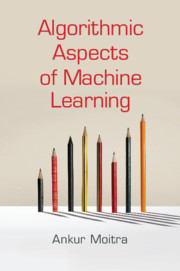Refine search
Actions for selected content:
48172 results in Computer Science

Algorithmic Aspects of Machine Learning
-
- Published online:
- 28 September 2018
- Print publication:
- 27 September 2018
Index
-
- Book:
- Algorithmic Aspects of Machine Learning
- Published online:
- 28 September 2018
- Print publication:
- 27 September 2018, pp 150-152
-
- Chapter
- Export citation
frontmatter
-
- Book:
- Geometric and Topological Inference
- Published online:
- 14 September 2018
- Print publication:
- 27 September 2018, pp i-iv
-
- Chapter
- Export citation
2 - Simplicial Complexes
- from Part I - Topological Preliminaries
-
- Book:
- Geometric and Topological Inference
- Published online:
- 14 September 2018
- Print publication:
- 27 September 2018, pp 10-20
-
- Chapter
- Export citation
Preface
-
- Book:
- Algorithmic Aspects of Machine Learning
- Published online:
- 28 September 2018
- Print publication:
- 27 September 2018, pp vii-viii
-
- Chapter
- Export citation
Bibliography
-
- Book:
- Algorithmic Aspects of Machine Learning
- Published online:
- 28 September 2018
- Print publication:
- 27 September 2018, pp 143-149
-
- Chapter
- Export citation
1 - Topological Spaces
- from Part I - Topological Preliminaries
-
- Book:
- Geometric and Topological Inference
- Published online:
- 14 September 2018
- Print publication:
- 27 September 2018, pp 3-9
-
- Chapter
-
- You have access
- Export citation
8 - Reconstruction of Submanifolds
- from Part III - Reconstruction of Smooth Submanifolds
-
- Book:
- Geometric and Topological Inference
- Published online:
- 14 September 2018
- Print publication:
- 27 September 2018, pp 137-160
-
- Chapter
- Export citation
3 - Tensor Decompositions: Algorithms
-
- Book:
- Algorithmic Aspects of Machine Learning
- Published online:
- 28 September 2018
- Print publication:
- 27 September 2018, pp 29-47
-
- Chapter
- Export citation
6 - Delaunay Filtrations
- from Part II - Delaunay Complexes
-
- Book:
- Geometric and Topological Inference
- Published online:
- 14 September 2018
- Print publication:
- 27 September 2018, pp 98-112
-
- Chapter
- Export citation
Part I - Topological Preliminaries
-
- Book:
- Geometric and Topological Inference
- Published online:
- 14 September 2018
- Print publication:
- 27 September 2018, pp 1-2
-
- Chapter
- Export citation
10 - Distance to Probability Measures
- from Part IV - Distance-Based Inference
-
- Book:
- Geometric and Topological Inference
- Published online:
- 14 September 2018
- Print publication:
- 27 September 2018, pp 180-196
-
- Chapter
- Export citation
11 - Homology Inference
- from Part IV - Distance-Based Inference
-
- Book:
- Geometric and Topological Inference
- Published online:
- 14 September 2018
- Print publication:
- 27 September 2018, pp 197-223
-
- Chapter
- Export citation
Part IV - Distance-Based Inference
-
- Book:
- Geometric and Topological Inference
- Published online:
- 14 September 2018
- Print publication:
- 27 September 2018, pp 161-162
-
- Chapter
- Export citation
4 - Tensor Decompositions: Applications
-
- Book:
- Algorithmic Aspects of Machine Learning
- Published online:
- 28 September 2018
- Print publication:
- 27 September 2018, pp 48-70
-
- Chapter
- Export citation
5 - Good Triangulations
- from Part II - Delaunay Complexes
-
- Book:
- Geometric and Topological Inference
- Published online:
- 14 September 2018
- Print publication:
- 27 September 2018, pp 69-97
-
- Chapter
- Export citation
7 - Triangulation of Submanifolds
- from Part III - Reconstruction of Smooth Submanifolds
-
- Book:
- Geometric and Topological Inference
- Published online:
- 14 September 2018
- Print publication:
- 27 September 2018, pp 115-136
-
- Chapter
- Export citation
Part III - Reconstruction of Smooth Submanifolds
-
- Book:
- Geometric and Topological Inference
- Published online:
- 14 September 2018
- Print publication:
- 27 September 2018, pp 113-114
-
- Chapter
- Export citation
